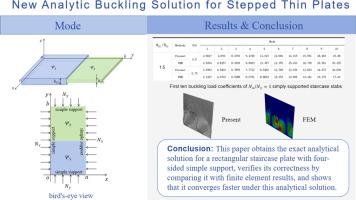New analytic buckling solution for stepped thin plates
IF 4.4
2区 工程技术
Q1 ENGINEERING, MULTIDISCIPLINARY
引用次数: 0
Abstract
This paper investigates the buckling problem of a four-sided simply supported stepped thin plate under bilateral loading using the sine superposition method and analytical solution methods. To date, the buckling problem of this structure has primarily been solved using numerical methods and finite element methods, and analytical solution methods for this structure have not yet been verified. However, in practical applications, analytical methods offer higher accuracy and efficiency compared to numerical methods. This method transforms the original problem into the superposition of four subproblems and derives their exact analytical solutions. By establishing the dual equations of the Hamiltonian system and combining them with continuity conditions and boundary conditions, the analytical expression for the critical buckling load is obtained. Case studies indicate that there is an interaction between the load ratio, length-to-width ratio, and thickness ratio. When the load ratio and length-to-width ratio remain constant, the buckling load coefficient increases with an increase in the thickness ratio; when the load ratio and thickness ratio remain constant, it decreases with an increase in the length-to-width ratio; when the thickness ratio and length-to-width ratio remain constant, it decreases with an increase in the load ratio. Convergence results indicate that convergence is achieved around the 40th series term, significantly faster than numerical methods and finite element methods, offering better real-time performance and cost-effectiveness in industrial design. This study provides an efficient theoretical tool for the buckling analysis and application of stepped thin plates.

阶梯薄板的一种新的解析屈曲解
本文采用正弦叠加法和解析解法研究了单边简支阶梯薄板在双向载荷作用下的屈曲问题。迄今为止,该结构的屈曲问题主要是通过数值方法和有限元方法来解决的,该结构的解析解方法尚未得到验证。然而,在实际应用中,分析方法比数值方法具有更高的精度和效率。该方法将原问题转化为四个子问题的叠加,并推导出它们的精确解析解。通过建立哈密顿系统的对偶方程,结合连续条件和边界条件,得到了临界屈曲载荷的解析表达式。实例研究表明,载荷比、长宽比和厚度比之间存在交互作用。当载荷比和长宽比一定时,屈曲载荷系数随厚度比的增大而增大;当载荷比和厚度比一定时,随长宽比的增大而减小;当厚度比和长宽比一定时,随荷载比的增大而减小。收敛结果表明,该方法在第40个级数项附近实现收敛,明显快于数值方法和有限元方法,为工业设计提供了更好的实时性和成本效益。该研究为阶梯薄板的屈曲分析和应用提供了有效的理论工具。
本文章由计算机程序翻译,如有差异,请以英文原文为准。
求助全文
约1分钟内获得全文
求助全文
来源期刊

Applied Mathematical Modelling
数学-工程:综合
CiteScore
9.80
自引率
8.00%
发文量
508
审稿时长
43 days
期刊介绍:
Applied Mathematical Modelling focuses on research related to the mathematical modelling of engineering and environmental processes, manufacturing, and industrial systems. A significant emerging area of research activity involves multiphysics processes, and contributions in this area are particularly encouraged.
This influential publication covers a wide spectrum of subjects including heat transfer, fluid mechanics, CFD, and transport phenomena; solid mechanics and mechanics of metals; electromagnets and MHD; reliability modelling and system optimization; finite volume, finite element, and boundary element procedures; modelling of inventory, industrial, manufacturing and logistics systems for viable decision making; civil engineering systems and structures; mineral and energy resources; relevant software engineering issues associated with CAD and CAE; and materials and metallurgical engineering.
Applied Mathematical Modelling is primarily interested in papers developing increased insights into real-world problems through novel mathematical modelling, novel applications or a combination of these. Papers employing existing numerical techniques must demonstrate sufficient novelty in the solution of practical problems. Papers on fuzzy logic in decision-making or purely financial mathematics are normally not considered. Research on fractional differential equations, bifurcation, and numerical methods needs to include practical examples. Population dynamics must solve realistic scenarios. Papers in the area of logistics and business modelling should demonstrate meaningful managerial insight. Submissions with no real-world application will not be considered.
 求助内容:
求助内容: 应助结果提醒方式:
应助结果提醒方式:


